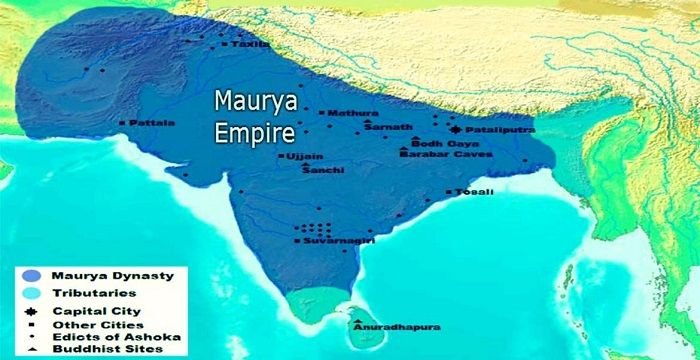The Maurya Empire, one of the most significant and influential empires in ancient India, played a pivotal role in shaping the course of Indian history. Spanning from 322 BCE to 185 BCE, the empire was known for its political unity, military strength, and rich cultural contributions. In this blog, we’ll delve into the history, achievements, and lasting impact of the Maurya Empire.
The Rise of the Maurya Empire
The Maurya Empire was founded by Chandragupta Maurya in 322 BCE, following the downfall of the Nanda Dynasty. Chandragupta, a visionary leader, rose from humble beginnings to establish one of India’s most powerful empires. His rise to power was marked by the guidance of his mentor Chanakya, a brilliant strategist and philosopher, who helped Chandragupta overthrow the Nanda Dynasty and establish the Maurya Empire.
Chandragupta’s leadership was instrumental in uniting a large part of the Indian subcontinent under a single administration, laying the foundation for what would become an empire that spanned from the northern plains to the Deccan Plateau.
The Reign of Ashoka: A Golden Age
One of the most iconic rulers of the Maurya Empire was Ashoka the Great, Chandragupta’s grandson. Ashoka’s reign (circa 268 BCE to 232 BCE) is often considered a golden age of the Maurya Empire due to his transformative policies and strong influence on Indian society.
Initially known for his military conquests, Ashoka’s most significant turning point came after the brutal Kalinga War. Witnessing the massive loss of life and suffering during the war, Ashoka experienced a deep personal transformation, renouncing violence and embracing Buddhism. His adoption of Buddhism profoundly impacted his rule, with Ashoka becoming a proponent of non-violence, religious tolerance, and welfare programs.
Ashoka’s Edicts, inscribed on pillars and rocks across the empire, are some of the earliest examples of written Indian history. These edicts, which emphasized moral and ethical governance, still serve as a testament to Ashoka’s enlightened leadership. They advocate for compassion, respect for all living beings, and the importance of social welfare.
Administration and Governance
The Maurya Empire was known for its efficient and centralized administration. Chandragupta Maurya established a bureaucratic system to manage the empire’s vast territories, dividing it into provinces, each governed by a royal prince or appointed official. The central administration was headed by the emperor, who had absolute authority over the affairs of the state.
The empire had a highly organized army, known for its sophisticated military tactics and innovative strategies. This enabled the Maurya Empire to maintain control over its vast territory and defend against external threats effectively.
Trade and commerce also flourished under Mauryan rule. The empire’s strategic position at the crossroads of important trade routes allowed for the exchange of goods, ideas, and culture with other regions, including Central Asia, the Mediterranean, and Southeast Asia.
The Fall of the Maurya Empire
Despite the early successes of the Maurya Empire, it eventually began to decline after Ashoka’s death. The empire faced internal strife, weak leadership, and economic challenges, which led to its fragmentation. By 185 BCE, the Maurya Empire had collapsed, and the last Maurya ruler, Brihadratha, was assassinated by his general, Pushyamitra Shunga, marking the end of the Maurya dynasty.
However, the legacy of the Maurya Empire endured long after its fall. Its achievements in governance, military strategy, and cultural development continued to influence subsequent Indian empires and dynasties.
Legacy of the Maurya Empire
The Maurya Empire left an indelible mark on Indian civilization. Here are some of its lasting legacies:
Political Unity: The Mauryas are credited with uniting large parts of India under a single empire, setting the stage for later Indian empires like the Gupta Empire.
Spread of Buddhism: Ashoka’s patronage of Buddhism helped spread the religion not just across India, but also to Central Asia, Southeast Asia, and beyond.
Architectural Contributions: The Mauryas are known for their architectural and artistic innovations, including the Ashokan Pillars, which are renowned for their inscriptions and inscriptions that still stand today.
Cultural Exchange: The empire’s trade and diplomatic relations led to the exchange of culture, art, and ideas with the outside world, enriching Indian civilization.
Conclusion
The Maurya Empire, with its strategic leadership, innovative governance, and cultural contributions, remains one of the most influential empires in Indian history. From Chandragupta’s unification of India to Ashoka’s propagation of Buddhism and ethical governance, the Mauryas set a high standard for rulers to follow. Their influence is still felt in modern-day India, from the Ashoka Chakra on the Indian national flag to the enduring lessons of Ashoka’s edicts on governance and compassion.
As we explore the rich legacy of the Maurya Empire, it serves as a reminder of the power of vision, leadership, and a commitment to peace, making it one of the most remarkable chapters in the history of ancient India.









